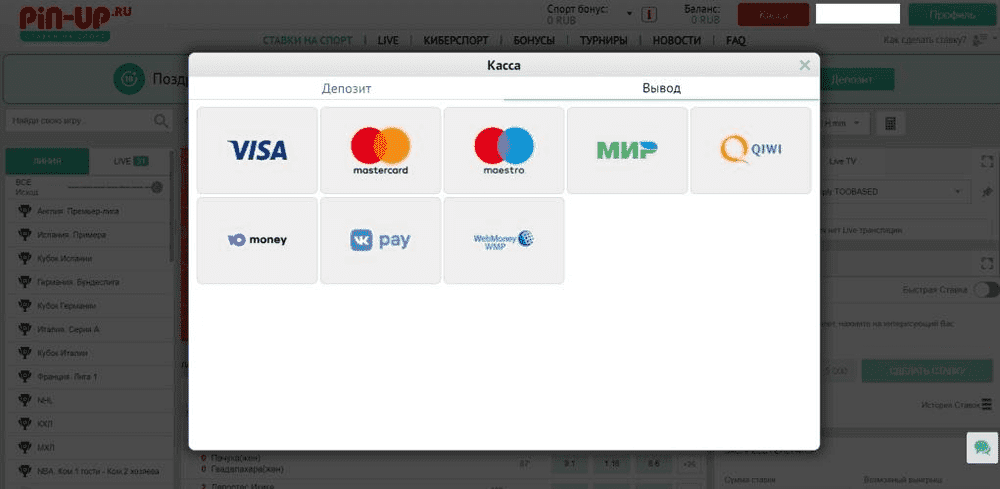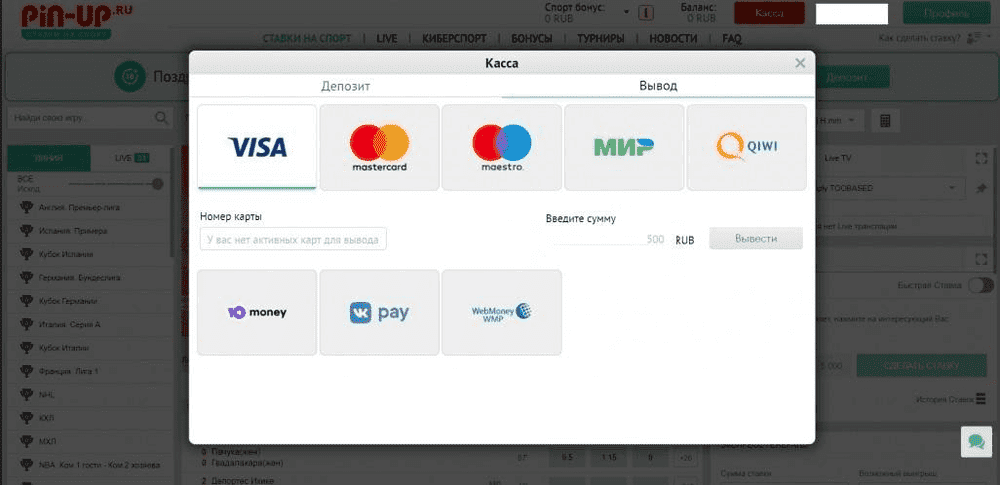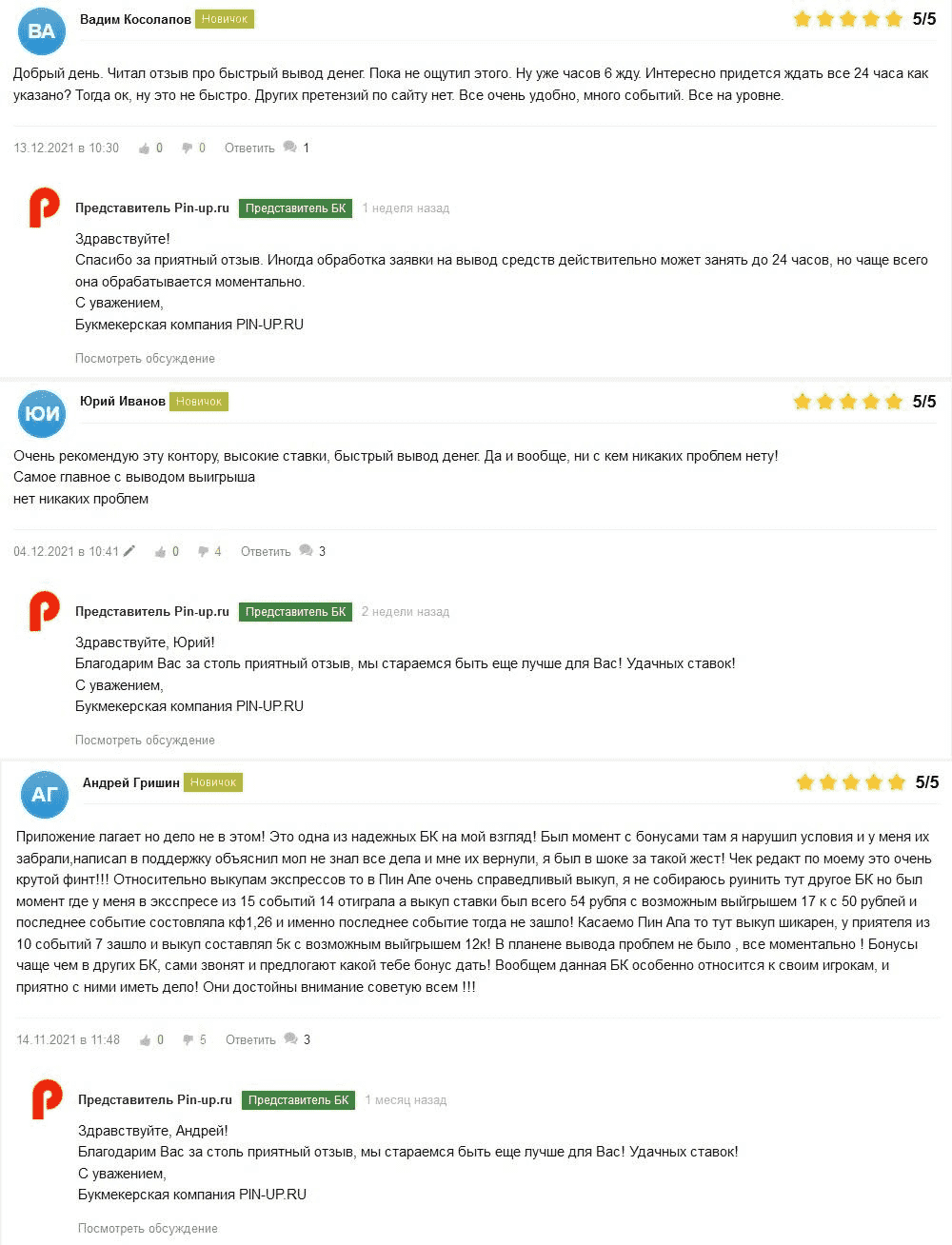Как вывести деньги Pin up
Все бетторы заключают пари в конторах для получения выигрышей. Мы советуем работать только с легальными букмекерами, которые гарантируют выплаты даже при некоторых спорных ситуациях. В этой статье мы рассмотрим, как выводить деньги в БК Пин-Ап. Далее будут подробно описаны важные вопросы, которые позволят вам избежать проблем при проведении транзакций.
Когда есть и нет возможности выполнять снятия средств
Для снятия выигрышей из системы необходимо внести депозит, сделать успешную ставку в букмекерской конторе Pin-Up и получить с нее выигрыш. Существуют факторы, при которых не получится пользоваться деньгами, например, клиент не прошел идентификацию в ЕЦУПС или на портале конторы. Еще валюта не проходит, когда указываются крупные суммы, беттор создал повторный аккаунт или подает заявку, размер которой меньше минимальной суммы.
Материалы по теме
Сколько времени процедура занимает
В конторе вывод денег для разных способов отличается по времени. Например, на кaрты банка и личный счет платежи проводятся до 3 рабочих дней. Это долго, но такая практика используется во всех конторах. Администрация компании безопасность клиентов ставит на первое место, поэтому выполняется проверка игрока. На электронные кошельки Киви, ЦУПИС, ЮМани валюта поступает в течение 1 минуты.
Какая минимальная и максимальная сумма для вывода
Лимиты на получение валюты напрямую зависят от используемого способа. Зачастую они ограничиваются возможностями платежных систем. Например, на электронные кошельки ЦУПИС, Qiwi, Юмани разрешается оформить заявку размером до 15 000 рублей. При помощи мобильной коммерции получать выигрыши нельзя, а на банковский счет и кaрты доступно снятие до 595 000 рублей. Минимальный платеж составляет 300 рублей на любую систему.
Кто имеет право пользоваться деньгами
Подавать заявку могут бетторы, которые соблюдают правила БК. Главное условие состоит в идентификации аккаунта. В некоторых случаях букмекер запрашивает дополнительные документы, например, загранпаспорт, водительское удостоверение или квитанции за оплату ЖКХ. При появлении уведомления о верификации учетной записи вывод средств приостанавливается до успешного прохождения операции.
Еще один важный момент состоит в отыгрыше депозита. Пользоваться деньгами можно на кaрту или электронный кошелек только после проставления всей суммы на спортивный исход с коэффициентом от 1.30. Если аккаунт игрока использовался третьими лицами, то денежные транзакции будут заблокированы.
Какие ограничения существуют
При выводе средств любым методом существуют ограничения, которые мы рассмотрим ниже:
- Факт выигрыша или проигрыша определяется на основе состоявшегося события или нескольких игр. Итоги противостояний берутся из официальных ресурсов организаторов.
- Беттор соглашается с тем, что букмекер может взять комиссию при выводе денег. Компания может отказаться проводить транзакцию, если комиссия будет сопоставима или больше заказанной выплаты.
- Вся внесенная на баланс сумма должна быть проставлена с коэффициентом от 1.30.
- В правилах конторы указано, что комиссия может достигать до 10% от размера депозита и фиксированный платеж до 500 рублей.
- Если беттор не выполняет условия БК, ему не будет проводиться выплата. Например, уклонение от полной верификации, создание повторного аккаунта или использование стратегии догон приводит к блокировке счета.
Что нужно для вывода средств: три самых важных условия
Каждый беттор должен знать три условия, без которых нельзя воспользоваться опцией выплат. Например, получать валюту можно только с помощью той платежной системы, по которой вносился депозит на игровой счет, а без идентификации не стоит даже пробовать подавать заявки — они не будут обработаны. Еще игроку потребуется изучить все виды ставок, чтобы понимать букмекерские рынки и не слить депозит.
Идентификация
Пользователи могут пройти начальную и полную верификацию аккаунта. К первому варианту относится верификация на официальном портале при помощи паспорта и при помощи сайта Госуслуг. Полную идентификацию можно выполнить в салонах Связной и Contact или при наличии активированной учетной записи в ЕЦУПС. Начальная идентификация позволит вносить на счет не более 60 000 рулей и снимать до 20 000 рублей в месяц, а полная проверка позволит убрать данные лимиты.
Выполняем идентификацию на ресурсе букмекера в следующем порядке:
- входим в личный кабинет;
- заполняем анкету в профайле, внимательно указываем предложенные данные;
- загружаем сканы нужных документов.
Длительность этой верификации составляет около 15 минут. Аналогичный процесс выполняется на площадке Госуслуги. Онлайн-верификацию могут пройти только граждане РФ. Еще игроку потребуется зарегистрироваться и выполнить идентификацию в ЕЦУПС. Затем синхронизировать аккаунты и начать игровой процесс.
Размещение ставок
Для заключения пари выполняем такие шаги:
- Открываем букмекерскую линию, находим подходящий матч и исход. Нажимаем на коэффициент рынка — к примеру, П2 означает выигрыш второго коллектива.
- Жмем «Билет», ссылка на раздел располагается в нижней части страницы.
- Заключаем пари, указываем сумму прогноза. Жмем «Сделать ставку».
- В случае успеха на счет беттора будет начислен выигрыш. Если это не акционные баллы, их разрешается получить.
Ввод и снятие через одну систему
Контора установила важное правило для клиентов, которое нужно учитывать при внесении депозита. Бетторы могут получать выигрыши только при помощи той системы, которой пополняли баланс. К примеру, если платеж проводился через банковскую карту, то именно на этот счет разрешается получить деньги.
Как вывести деньги
Если пользователь не знает инструкцию по выводу денег, он не сможет стать успешным игроком. Доход будет оставаться на счету, и беттор его постепенно сольет. Управлять банкроллом необходимо правильно, например, 30% от выигрыша каждый месяц нужно изымать из оборота на собственные нужды. Дальше мы рассмотрим подробные инструкции для каждого способа.
Общий алгоритм вывода денег
Порядок получения выплаты в конторе:
- Открываем букмекерскую площадку. В шапке портала жмем «Войти», вводим логин, пароль для авторизации.
- Откроется окно для работы с деньгами. Переходим во вкладку выплат.
- Выбираем способ проведения платежа, например, Visa. Ниже отобразится панель для ввода ее номера и суммы. Жмем на кнопку выплат.
- Откроется сайта ЕЦУПС. На телефон беттора будет отправлен проверочный код по SMS. Вводим его в соответствующую строку для подтверждения выбранного действия.
Условия вывода средств
Если вы хотите успешно вывести средства с баланса БК, то соблюдайте такие условия:
- При создании аккаунта указывайте правильный номер телефона, на него будет отправляться проверочный код по SMS для получения выплаты.
- Получить выигрыш можно на ту карту банка, с которой выполнялось минимум одно пополнение счета.
- Имя беттора в конторе и владельца счета или карты должны совпадать.
- Пользователь выполнил все условия букмекера.
Все доступные способы
Пин-Ап предлагает бетторам выбрать подходящий способ работы с деньгами, например, карты банка, Юмани, Киви и другие системы. У каждого метода есть свои особенности. Задача игрока состоит в четком соблюдении инструкции по подаче заявки. Дальше мы рассмотрим способы для всех доступных вариантов платежей.
С помощью Visa/Mastercard
Букмекер поддерживает банковские кaрты, которые выпущены учреждениями из РФ. Некоторые системы могут брать комиссию за перевод средств. Компания заявила время проведения платежа — до 3 рабочих дней. На практике игроки получают деньги в течение нескольких часов. Инструкция по заказу выплаты на карты Visa/Mastercard:
- выполняем авторизацию на букмекерском ресурсе;
- в личном кабинете переходим в меню «Касса»;
- указываем банковскую карту VISA;
- вводим размер транзакции;
- жмем кнопку снятия;
- получаем код по SMS для подтверждения операции, вводим его в соответствующей строке.
С помощью платежной системы Qiwi
Ранее букмекер относился к Киви ЦУПИС, поэтому данный кошелек был у всех клиентов. Сейчас на него можно перевести до 15 000 рублей, комиссия отсутствует. Операция проводится в течение 1 минуты. Рассмотрим инструкцию для использования данной платежной системы:
- входим в личный кабинет компании;
- в верхней панели управления нажимаем на красную кнопку «Касса»;
- указываем вкладку выплат, жмем на кнопку «Qiwi»;
- пишем номер кошелька, сумму, нажимаем на кнопку, которая дает возможность получить средства;
- подтверждаем перевод на ресурсе ЕЦУПС с помощью проверочного кода из SMS.
С помощью платежной системы ЮMoney
Выполняем инструкцию:
- проводим вход в ЛК букмекера;
- в меню «Касса» выбираем раздел «Вывод»;
- указываем номер счета Юмани, размер перевода, жмем кнопку выплат;
- на телефон по SMS придет проверочный код, вводим его для подтверждения операции.
Другие популярные способы вывода денег
Еще один популярный метод вывода выигрышей — это кошелек ЦУПИС. Инструкция по его использованию:
- выполняем авторизацию в Пин-Ап;
- в меню «Касса» в подразделе «Вывод» жмем «Кошелек ЦУПИС»;
- указываем номер кошелька, сумму платежа, нажимаем кнопку выплат;
- вводим полученный код по SMS, подтверждаем перевод.
Как вывести средства с мобильной версии сайта и в приложении
Бетторы с телефона могут работать со всеми функциями букмекерской конторы, например, регистрация, пополнение счета, пользование деньгами, заключение пари. В мобильном приложении и в версии портала для смартфонов используется аналогичный дизайн и интерфейс. Пользователи не замечают разницы между этими платформами. Ниже мы рассмотрим процедуру получения выигрышей в мобильной версии ресурса:
- Выполняем вход в личный кабинет. В верхней панели управления находится кнопка «Касса», нажимаем на нее.
- В появившемся окне переходим в подраздел снятия, где выбираем подходящий способ: кaрта, электронный кошелек, банковский счет.
- Вводим реквизиты платежного метода, сумму для вывода. После этого жмем на зеленую кнопку «Вывести».
- Любой платеж в системе необходимо подтвердить при помощи проверочного кода, который отправляется по SMS. Он состоит из 6 символов, вводим их в соответствующей строке. Нажимаем на кнопку «Подтвердить».
Комиссия и налоги в БК
Клиенты всех легальных контор в России должны платить налоги с выигрышей. Доходом считается сумма, которую беттор повторно выводит со своего баланса. Например, пользователь выполнил депозит на сумму 7 000 рублей, а подал заявку на получение 2 000 рублей после чего еще 3 000 рублей. В данной ситуации доходом будет считаться 3 000 рублей. В учет идут выплаты за год.
Если беттор выводит менее 4 000 рублей, то платить налог не нужно. Если в течение года он получает от 4 000 до 15 000 рублей, то необходимо самостоятельно решить вопрос, заполнив декларацию в ФНС. Налог при снятии 15 000 рублей и больше берет контора в автоматическом режиме, в данной ситуации вам ничего делать не нужно.
Пользователи должны понимать, как именно изымаются выигрыши. Налог для выигрышей составляет 13% — например, с 17 000 рублей будет удержано 2 210 рублей. Пока валюта находится на игровом счете, игроки ничего не платят государству. Эта сумма подлежит налогообложению только во время вывода. Букмекер не берет комиссию за отправку денег бетторам.
Почему банки могут блокировать платежи
На практике встречаются ситуации, когда банки блокируют платежи и кaрты клиентов. Игрокам нужно быть готовым к любой ситуации. Например, в интернете получила большой ажиотаж история, когда была заблокирована кaрта беттора по причине получения сомнительного платежа. Главная проблем в данном вопросе — это отсутствие информации, как себя вести в подобных ситуациях. Если банк вам заблокировал платеж, необходимо сделать скриншоты в ЕЦУПС, связаться с техподдержкой учреждения и доказать, что данная транзакция не является сомнительной и с нее уплачены налоги.
Что делать при отказе в выводе денег
Если букмекер не выплачивает выигрыши, необходимо определить причину блокировки. Это могут быть такие ситуации:
- превышение максимального лимита;
- ошибки в работе ЕЦУПС;
- потеря пароля;
- договорные матчи;
- синдикаты;
- мультиаккаунтинг;
- бонусхантинг;
- отказ от повторной идентификации.
Если вы уверены в том, что не нарушали условия сотрудничества, то можете обратиться в техподдержку. Операторы должны предоставить ответ, почему произошел отказ. Если вы не смогли решить проблему, стоит обратиться в другие сервисы, например, в администрацию ЕЦУПС или к независимым беттинговым форумам. На таких платформах пользователи часто пишут о своих проблемах и для восстановления доверия букмекеры оперативно отвечают на вопросы.
Какие частые ошибки совершаются
Существует много ошибок, из-за которых невозможно провести транзакцию. Например, попытка получить больше, чем есть на счете, превышение максимума или заявка на сумму меньше минимума, не отыграны все бонусы. Одной из самых распространенных ошибок в Пин-Ап является то, что бетторы не выполняют условия по обороту депозита. Для решения проблемы необходимо ознакомиться с правилами компании.
Отзывы и мнения экспертов
Бетторы в интернете обсуждают сотрудничество с БК Pin-Up. Клиент Вадим Косолапов пишет, что появились задержки при выплате выигрышей. Юрий Романов доволен всем функционалом конторы, например, быстрым выводом денег, высокими коэффициентами, большой линией в лайве и прематче.
Отзывы взяты с сайта Рейтинг Букмекеров.
Один раз задержали почему-то вывод на сутки почти. Я полез читать отзывы и каждый второй пишет “мошенники”. Ну все уже попрощался с деньгами. В итоге это у меня просто карточка просрочена оказалась. Сделал заново вывод на другую электронную карту и все прошло нормально. В целом уже сделано больше 100-150 выводов. Деньги почти всегда приходят в течение 5-10 секунд. Да и вообще забыл про нелегальные конторы, так как легальные быстро и 100% выплачивают выигрыш.
Content Игры и ставки Букмекерской конторы Пин ап Спортивные ставки bet’s Pin Up Betting Пин Ап Топовая букмекерская контора Pin up bet — лучшие условия для ставок на спорт Ставки: процентный фрибет на Dota2 от БК Pin-Up.Bet Лучшие бонусы от РБ Как делать ставки на спорт? Пин ап ставки Бонусы Pin up ставки на спорт…
Read more
Официальный клиент новой букмекерской конторы с положительной репутацией, которая позволит вам зарабатывать реальные деньги, делая ставки на те или иные спортивные события. Заключайте пари и богатейте, радуясь победам любимых команд!
Flashscore — wyniki na żywo FlashScore Poland · Спорт
Если вы уже много лет играете в онлайн казино pin-up, то знаете , что зачастую приходится тратить немало времени на поиски подходящего игрового зала.
Другие запросы похожие на Игровое Зеркало Пин Ап ищут:
- Пин Ап Бесплатная Ставка
- Pin Up Как Сделать Ставку Win
- Пин Ап Слоты С Минимальными Ставками
- Лига Ставок Pin Up Пин Ап
- Игры Пинап Ставка 1 Рубль
Content Как сделать в Мостбет бездепозитный бонус? Скачать MostBet 5.9.3 APK Скачать официальное приложение “Мостбет” на компьютер Дизайн и интерфейс приложения Скачать Mostbet UZ на
Количество ставок для одного аккаунта не ограничено.
Акция доступна для всех игроков.












